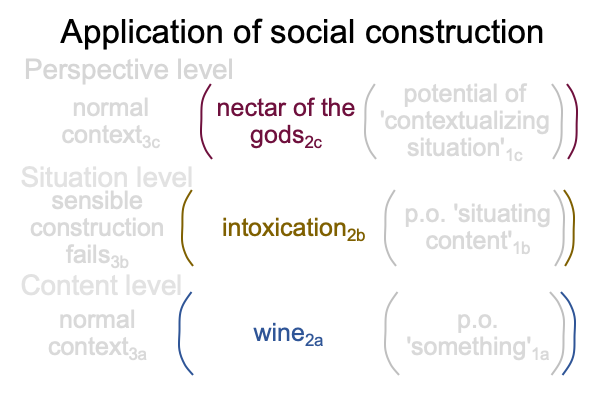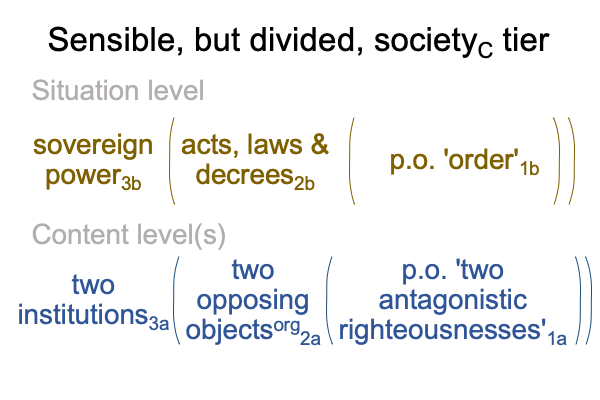Looking at Razie Mah’s (2015) The Second Primer of the Organization Tier (Part 12 of 24)
0063 The fifth primer of the organizationB tier wrestles with two interscopes. The content-level becomes the corporation interscope. The remaining situation and perspective levels remain nested forms.
Perhaps, one day, these, too, will differentiate into interscopes.
0064 For the moment, I want to focus on the contenta and the situationb levels of organizationB tier.
Recall that a three-level interscope associates with social construction and a two-level interscope goes with sensible construction. In the former, the perspective-level actuality serves as a social construction. In the latter, the situation-level actuality operates as a sensible construction.
0065 Yes, both types of construction are in play. The corporationaB, the content level of the organizationB tier, is sensibly situated by the situation level, exchangebB. But, the contentaB level is a three-level interscope.
So, the perspective levelc of the content-levelaB interscope has the same relational structure as social construction. And, the situationb level of the organizationB tier manifests the relational structure of sensible construction.
0066 Here is a picture.

0067 In sum, exchangebB associates with sensible construction and the perspectivec level of the corporationaB associates with social construction.
0068 So I ask, “How does the marketbB virtually situate the managementc level of a corporationaB?”
0069 Consider biology. The body is the actuality2 in the perspectivec level of the corporationaB interscope. What actuality2bB virtually situates the body2caB? Encountering the world2bB does.

0070 How sensible is that?
0071 What happens when my body2caB encounters the world2bB?
Well, I see, hear, smell, touch and maybe, taste the world. Also, I have feelings about those sensations. The medieval scholastics have a word for this combination of sensations and feelings. The Latin term is species impressa. Say the word like you are ordering it in an Italian restaurant.
Does the term sound vaguely familiar?
What if I say that an impression is a dyadic actuality: active body [substantiates] sensate soul?
Does that help?
0072 Does the same relational structure apply to a commercial enterprise?
Here is a picture.

0073 Well, I suppose that a bakery business2caB is like a body2caB, even though I never thought that I am running my body like a business. It seems that my body2caB runs itself.
Also, I never imagined that a customer buying a loaf of bread2bB is how a bakery encounters the world2bB. At the same time, I can see that the relational structure is similar. Sensible construction applies, until something goes wrong.
0074 What an unanticipated way to enter the discipline of economics.
Encounters with the world2bB are certainly causal. They occur in the realm of actuality. So do purchases of loaves of bread2bB.
Since the realm of actuality corresponds to the category of secondness and since secondness consists in two contiguous real elements, I may ask, “What are the real elements involved?”
0075 Well, it depends on the question (that is, the normal context).
Okay, the question is, “Why does this exchange occur?”
Well, the baker wants to sell the bread. I call the bread, “a quality product”.
Plus, the customer wants to buy the bread. I call the willingness, “demand”.
These two realnesses are somehow contiguous.

0076 What is the contiguity?
Price?
Price is not a thing. It is the contiguity between a willingness to sell and a willingness to buy. As such, price is substantial. Price is a site of contention.
The Second Primer on the Organization Tier introduces economic concepts, such as quality and demand. It does so without naming the upperC tier.
0077 The organizationB tier, like the individual in communityA tier, is a noumenon, a thing itself, whose phenomena are subject to scientific inquiry. Phenomena are the observable and measurable facets of a noumenon.
What does this imply?
Science investigates phenomena. A noumenon cannot be reduced to its phenomena. So, scientific inquiry cannot elucidate the noumenal features of either the organizationB or the personA.
In contrast, the category-based nested form can.
0078 How so?
Economics can measure and observe prices and build models and discuss these models using its disciplinary language.
But, economics cannot objectify the thing itself.
Price is the contiguity between two real motivations.
In order to understand price, one must inquire about these motivations.
0079 Thus, at this juncture, I implore the reader to consider teaching these primers, as well as the masterwork, How To Define the Word “Religion”. The method is read and discuss.
0080 This course is a wonderful way to introduce your children and your students to the difference between science and understanding. Search for the keywords, Razie Mah, series, How To Define The Word “Religion”.
Once again, here is a picture of the difference.















